Please use this identifier to cite or link to this item:
https://hdl.handle.net/20.500.12202/4476| Title: | לבוא ולהיכנס : Synchronic and Diachronic Aspects of the Semantics of ‘Coming’ and ‘Going’ in Ancient Hebrew, |
| Other Titles: | : לבוא ולהיכנס: היבטים סינכרוניים ודיאכרוניים בסמנטיקה של הפועל "לבוא" בעברית העתיקה |
| Authors: | Koller, Aaron |
| Keywords: | semantics of בוא Hebrew verbs diachronic mode historical linguistics |
| Issue Date: | 2013 |
| Publisher: | Academy of the Hebrew Language |
| Citation: | Koller, Aaron. (2013). לבוא ולהיכנס : Synchronic and Diachronic Aspects of the Semantics of ‘Coming’ and ‘Going’ in Ancient Hebrew. Lešonénu 75, 149-164 [Hebrew] |
| Series/Report no.: | Lešonénu;75(2/3) |
| Abstract: | This paper investigates the semantics of the verb בוא in ancient Hebrew. After reviewing some of the scholarship on the semantics of English 'to come', it shows that in many respects biblical בוא differs from 'to come'. Instead, the Hebrew verb means 'motion towards, or into, a defined location'. Moving to a diachronic mode, the paper demonstrates that the fixed distinction in Aramaic between 'to arrive at' (אתי) and 'to enter' (עלל) was introduced into ancient Hebrew as well, under the influence of Aramaic. This process was linked to the introduction of an important new word, נכנס, whose history (internal and external to Hebrew) is traced. Finally, the semantic situation in mishnaic Hebrew is described, once נכנס usurped much of the semantic territory that had belonged to biblical בוא. |
| Description: | Scholarly article |
| URI: | https://www.jstor.org/stable/24328421 https://hdl.handle.net/20.500.12202/4476 |
| ISSN: | 03343626 |
| Appears in Collections: | Yeshiva College: Faculty Publications |
Files in This Item:
| File | Description | Size | Format | |
|---|---|---|---|---|
| Koller לבוא ולהיכנס (Leshonenu 2013) HebAcad em 26Jun.pdf | PDF author | 689.49 kB | Adobe PDF |  View/Open |
This item is licensed under a Creative Commons License

